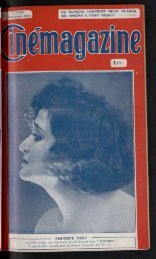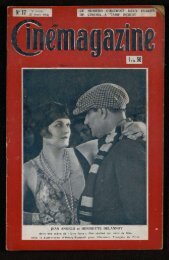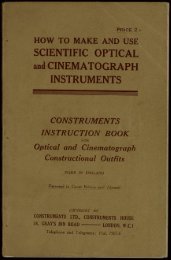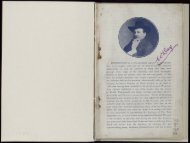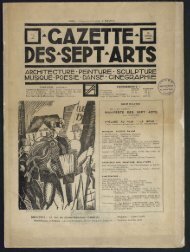Untitled
Untitled
Untitled
Create successful ePaper yourself
Turn your PDF publications into a flip-book with our unique Google optimized e-Paper software.
74 MODERN MAGIC LANTERNS.<br />
is, if the screen has the position indicated by one or other of<br />
the dotted lines, the pictures thrown upon it will be distorted.<br />
It will be seen from this that if the lantern is tipped<br />
up or down the screen must not be vertical. The same remarks<br />
apply with equal force to the turning of the lantern<br />
to one side or the other.<br />
Having seen about this, the lantern can be lit up, when,<br />
if limelight is to be used, the light will have to be centred,<br />
that is, adjusted until the brightest part of the lime is in<br />
the axis of the lantern, and is also at the focus of the<br />
condenser. (Oil lamps are not provided with a means of<br />
centering the light, as its position is invariable, and is or<br />
Fig. 59. PHOTOGRAPHS OF THE SCREEN WITH<br />
THE JET IN AND OUT OF POSITION.<br />
should be adjusted by the maker.) To do this, the jet having<br />
been lit and the oxygen turned on, a slide must be put into<br />
the lantern, and disregarding for the moment whether its<br />
illumination is even or not, focussed upon the screen, after<br />
which it can be taken out without disturbing the focussing.<br />
The chances are that the circle of light upon the sheet will<br />
now resemble either A, B, C, D, or E, Fig. 59, which indicate<br />
respectively that the light is too high (A), too low (3), too<br />
much to the right (c), or to the left (c). This must be corrected<br />
by slackening the screw which holds the jet in position<br />
on the tray pin, and finally clamping it again when the disc<br />
presents the appearance denoted by E. When this is the<br />
THE MANIPULATION OF THE LANTERN. 75<br />
case, the light is centred, and must then be adjusted as<br />
regards its distance from the condenser. This is done by<br />
sliding tray and all in the grooves of the lantern until the<br />
disc is evenly and brightly illuminated all over (F) ; the<br />
correct position is easily found. The carrier should then be<br />
adjusted so that its opening occupies the centre of this disc,<br />
and if it can be clamped in that position when found, so<br />
much the better. This being done, it is useful to put a slide<br />
once more into the carrier, and with the rack and pinion<br />
motion of the lens midway, i.e., neither fully in nor fully<br />
out, to focus it with the sliding adjustment only. If this is<br />
not done, it may be found that it is impossible to focus<br />
each slide sharply with the rack and pinion because it is at<br />
the end of its travel.<br />
The slides demand the next attention. If practicable it<br />
will be found an excellent plan to tie them up in a paper<br />
parcel and put them in a warm oven for a little while. If<br />
this cannot be done they may be warmed by being placed<br />
in an open grooved box before the fire, or even allowed to<br />
remain, separated, in a warm room for a little while. Unless<br />
this is done, there will be a great likelihood in the intense<br />
heat of the limelight or electric light of the deposition of<br />
moisture on the cold slide when put into the lantern. The<br />
slides when this is the case are said to "sweat," it is painfully<br />
obvious on the screen, and will spoil completely an<br />
exhibition which is in all other respects first-class.<br />
The slides must be arranged in the order in which they<br />
are required. For this purpose they are often kept in<br />
grooved boxes, but this way may lead to mistakes. The<br />
most careful lanternist may have his attention distracted<br />
for a moment, and in the obscurity may take a slide from<br />
any part of the box instead of the next in order, and so get<br />
them disarranged and make one of those slight but annoying<br />
hitches which mar what should be the regularity which leads<br />
to success. For this reason we prefer to have the slides<br />
piled up in stacks of about thirty, only one of which shall be<br />
within reach at a time, there is then no possibility that any<br />
slide but the next in order can be picked up by accident.<br />
Another important detail is the proper marking of the<br />
slides. There has been for many years every possible



